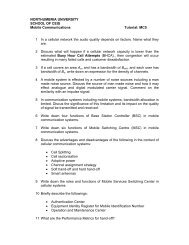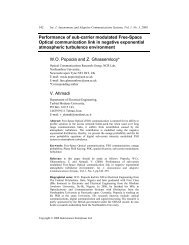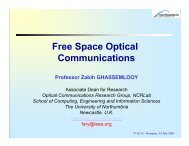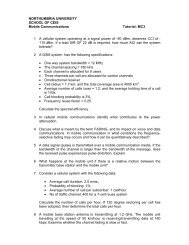Optical Time Division Multiplexing - Northumbria University
Optical Time Division Multiplexing - Northumbria University
Optical Time Division Multiplexing - Northumbria University
Create successful ePaper yourself
Turn your PDF publications into a flip-book with our unique Google optimized e-Paper software.
All <strong>Optical</strong> <strong>Time</strong> <strong>Division</strong> <strong>Multiplexing</strong> -<br />
An alternative to WDM<br />
Professor Z. GHASSEMLOOY<br />
<strong>Optical</strong> Communications Research Group<br />
School of Engineering,<br />
Sheffield Hallam <strong>University</strong><br />
UK<br />
Tel: +44 114 225 3274<br />
Fax: +44 114 225 3433<br />
email: z.f.ghassemlooy@shu.ac.uk<br />
Wed add.: http//www.shu.ac.uk/ocr
<strong>Optical</strong> Communications Research Group<br />
People<br />
• Academics 4<br />
ú Engineers, and Mathematicians<br />
• Research Students 7<br />
• MSc Students 2
OCRG - Current Research<br />
• All <strong>Optical</strong> <strong>Time</strong> <strong>Division</strong> <strong>Multiplexing</strong><br />
ú Terahertz <strong>Optical</strong> Asymmetric Demultiplexers<br />
ú <strong>Optical</strong> Buffering<br />
ú <strong>Optical</strong> Packet Networking<br />
ú <strong>Optical</strong> Routing<br />
• <strong>Optical</strong> Wireless Communication System<br />
- Modulation Schemes - CDMA<br />
- Intelligent <strong>Optical</strong> Receiver<br />
• <strong>Optical</strong> Sensors
Our Work<br />
• System approach<br />
ú Theoretical Investigation<br />
ú Simulation<br />
• Analytical<br />
• Computer<br />
ú Design<br />
ú Implementation
All <strong>Optical</strong> <strong>Time</strong> <strong>Division</strong> <strong>Multiplexing</strong><br />
an overview
All <strong>Optical</strong> Networks Layered Structure<br />
To overcome the bandwidth bottleneck due to opto-electronic<br />
or electro-optic conversion in existing network based on<br />
optical transmission and electronic switching<br />
<strong>Optical</strong> channel layer<br />
<strong>Optical</strong> multiplex layer<br />
<strong>Optical</strong> transmission layer
Network Technologies<br />
Channels<br />
Fibre<br />
Channels<br />
MUX E/O<br />
O/E DEMUX<br />
Electrical<br />
Bottlenecks<br />
Channels<br />
E/O<br />
Fibre<br />
O/E<br />
Channels<br />
E/O<br />
MUX<br />
DEMUX<br />
O/E<br />
E/O<br />
O/E<br />
<strong>Optical</strong><br />
Control signal
All <strong>Optical</strong> <strong>Multiplexing</strong><br />
Is the key in meeting the explosive bandwidth requirement<br />
of future communication networks!<br />
• Wavelength division multiplexing (WDM)<br />
• <strong>Optical</strong> time division multiplexing (OTDM) P<br />
• Hybrid WDM-OTDM
WDM<br />
• Up to 90 wavelengths<br />
• > 200 Gbps<br />
• Transparent to data<br />
format and rate<br />
Channels<br />
E/O<br />
λ 1<br />
λ 2…<br />
λ M<br />
O/E<br />
Channels<br />
E/O<br />
MUX<br />
OA<br />
DEMUX<br />
O/E<br />
E/O<br />
Fibre<br />
O/E
Problems with WDM<br />
• Nonlinearity associated with fibre, eg. Stimulated Raman<br />
Scattering results in SNR degradation as the number of<br />
channel increases<br />
• Four wave mixing: limits the channel spacing<br />
• Cross phase modulation: limits the number of channels<br />
• High gain flat amplifiers<br />
• Packet switched service by means of light paths: an<br />
extremely inefficient way of utilizing network resources<br />
Solution<br />
• <strong>Optical</strong> <strong>Time</strong> <strong>Division</strong> <strong>Multiplexing</strong> (OTDM)<br />
(introduced early 90’s)
OTDM – What does it offer?<br />
• Flexible bandwidth on demand at burst rates of 100 Gb/s per<br />
wavelength (in the longer term).<br />
• The total capacity of single-channel network = DWDM ,<br />
but OTDM provide:<br />
ú potential improvements in network performance in terms of user<br />
access time, delay and throughput, depending on the user rates and<br />
statistics.<br />
• Less complex end node equipment (single-channel Vs. multichannels)<br />
• Can operate at both:<br />
ú 1500 nm (like WDM) due to EDFA<br />
ú 1300<br />
• Offers both broadcast and switched based networks
OTDM - History<br />
• 1968 T S Kinsel & R T Denton, IEEE Proc. 56,<br />
• 1970 S J Buchsburn & R Kompfiner, ‘TDM <strong>Optical</strong> transmission systems’,<br />
• 1981 M Thewalt, - ‘OTDM using mode locked laser’, Elec. Lett.<br />
• 1985 S K Korothy et al - ‘ High speed LiNbO3 as switch/modulator for<br />
OTDM’<br />
• 1988 S Fujita - 10 Gbps systems<br />
• 1993 A D Ellis - 40 Gbps<br />
• 1998 M Nakazawa - 640 Gbps (60 km)<br />
• 1999 P Tolire, et al - 100 Gbps Packet based<br />
• 2000 K Yanenasu – 80 Gbps (168 km zero dispersion fibre)
Progress in Raw Speed<br />
1000<br />
Source: W H Knox, 2000<br />
Bit time (ps)<br />
100<br />
10<br />
1.0<br />
2.5 Gb/s<br />
Sub-picosecond region<br />
0.1<br />
1980 1985 1990 1995 2000 2005<br />
Year<br />
40 Gb/s<br />
1.24Tb/s<br />
• 2000 - 40 Gb/s commercial product<br />
•1.28 Tb/s uses 200 fs pulses, using optical loop mirrors for<br />
demultiplexing (not possible electrically)
Ultrafast broadband<br />
source<br />
Ultrafast Technology Impact on WDM and<br />
OTDM<br />
1000<br />
Number of wavelength<br />
100<br />
10<br />
1.0<br />
100Tb/s<br />
1 Tb/s 10 Tb/s<br />
Ultrafast OTDM limits<br />
1 10 100 1000 10000<br />
Data rate (Gb/s) /wavelength<br />
• Source: DFB laser<br />
• 10000 WDN is achieved using spectral slicing
Ultrafast Pulse Source<br />
1000<br />
50 GHz Bandwidth<br />
WDM channels<br />
100<br />
10<br />
1<br />
10 100 1000<br />
Pulse width (fs)<br />
Commercial WDM 80 channels or more
OTDM Broadcast<br />
and<br />
Switched Based Networks
A- Broadcast OTDM Networks<br />
• Bit interleaving:<br />
ú Each node will have a pair of OTDM Tx/Rx.<br />
ú Just like broadcast WDM networks, it requires multi-channel<br />
media access protocol.<br />
- Star: Offers better link budget<br />
- Bus: Offers natural ordering of nodes, easier<br />
• Packet interleaving<br />
synchronisation and protocol design.<br />
ú No need for multi-channel media access control<br />
ú Requires single-channel media access protocol
1- Bit Interleaved - Multiplexer<br />
Data (NRZ)<br />
Fibre delay τ<br />
M1<br />
Mode-locked<br />
laser<br />
Splitter<br />
Fibre delay iτ<br />
Node i<br />
Fibre delay (N-1) τ<br />
Mi<br />
M(N-1)<br />
Combiner<br />
or<br />
star coupler<br />
OTDM<br />
Modulators<br />
Frame pulse<br />
• Data rate: 100 Mb/s:<br />
Ethernet at 10 Mb/s,<br />
Token Ring at 10 Mb/s,<br />
or FDDI at 100 Mb/s.<br />
Tb<br />
Framing pulses<br />
Frame 1 Frame 2<br />
T ip<br />
= T b<br />
/N+1<br />
<strong>Time</strong>
Bit Interleaved - De-multiplexer<br />
OTDM<br />
Splitter<br />
or<br />
star coupler<br />
A<br />
Fibre delay jτ<br />
&<br />
Channel j<br />
B<br />
C<br />
A<br />
Threshold level<br />
B<br />
C<br />
Channel j
2- Packet Based<br />
• Data rate 100 Gbps/channel<br />
• Packet duration = 10 ns – 100 ps<br />
Ch- 1<br />
Header<br />
Data<br />
Burst (packet)<br />
Guard band<br />
Ch- 2<br />
S-OTDM<br />
Slot1 Slot 2<br />
<strong>Time</strong><br />
Ch- N<br />
•Signal processing, switching and routing are<br />
carried out during guard band time
Packet OTDM - Multiplexer<br />
Mode-locked<br />
laser<br />
a<br />
Mod. data<br />
b<br />
Compression<br />
c d e<br />
Modulator 1 st stage 2 nd stage i th stage<br />
OTDM<br />
a)<br />
b)<br />
1 0 1 1 0 1<br />
c)<br />
Pulse i location<br />
at the output is:<br />
(2 k - 1)(T - t) +<br />
(i - 1)τ<br />
d)<br />
e)<br />
OTDM<br />
T-τ<br />
2 (T-τ)<br />
Compressed<br />
packet
Packet Compression<br />
T<br />
(T-τ) 2(T-τ) 4(T-τ) 8(T-τ)<br />
τ<br />
Input<br />
I in<br />
(t)<br />
Output<br />
I out<br />
I<br />
in<br />
( t)<br />
=<br />
N −1<br />
∑<br />
i=<br />
0<br />
I<br />
i<br />
( t)<br />
=<br />
N −1<br />
∑<br />
i=<br />
0<br />
δ(<br />
t<br />
− iT ) A<br />
i<br />
I i<br />
(t) is the ith bit in the packet<br />
A i<br />
= 0 or 1<br />
O ( t)<br />
=<br />
• For a single bit the composed output is:<br />
∑ − i n<br />
2 j=<br />
1<br />
N 1<br />
I [ − ( − τ<br />
+ i<br />
t j T<br />
0<br />
1<br />
)]<br />
• The output signal for<br />
N bits packet is:<br />
I<br />
out<br />
=<br />
N−1<br />
∑<br />
i=<br />
0<br />
O<br />
i<br />
=<br />
2<br />
N −1<br />
N −1<br />
1<br />
n+<br />
1<br />
∑<br />
i=<br />
0<br />
∑<br />
j=<br />
0<br />
I<br />
i<br />
[ t<br />
− ( i<br />
+<br />
j)<br />
T<br />
+<br />
jτ]<br />
A<br />
j
Packet OTDM- De-multiplexer<br />
Compressed<br />
packet<br />
Splitter<br />
&<br />
&<br />
Control<br />
signals<br />
&<br />
&<br />
&
OTDM Demultiplexer<br />
OTDM<br />
Demux<br />
Ch- 1<br />
Clock<br />
syn.<br />
Clock<br />
• Synchronisation of the control signal is essential to achieve<br />
accurate demultiplexing. This requires the extraction of a clock<br />
component from the received data using:<br />
• electro-optical<br />
- PLL<br />
• all optical at high speed > 40 Gbps<br />
- mode-locked fibre ring laser
Broadcast OTDM Networks - Problems<br />
• Large splitting loss<br />
• No routing or switching (signals are sent to all nodes)<br />
Solution:<br />
• Switched based networks<br />
ú Tune-ability: select any time slot<br />
ú Routing and switching<br />
ú Much faster
B- Switched Based OTDM Networks<br />
• Broadcast topology & media access protocol<br />
ú Ethernets<br />
ú Token rings<br />
ú FDDI<br />
• Store & forward topology<br />
ú Mesh<br />
ú ATM<br />
ú IP<br />
2<br />
4<br />
S/W & routing nodes<br />
3<br />
Source & sink nodes<br />
1 3
Switched Based OTDM Networks Node –<br />
Routing & switching<br />
• Packet may specify:<br />
ú Route chosen<br />
ú Destination node (the choice of route is left to the routing nodes)<br />
I/P<br />
buffers<br />
Header recognition<br />
O/P<br />
buffers<br />
Packets<br />
DeMUX<br />
Processing<br />
Switch<br />
DeMUX<br />
Processing<br />
Control Input<br />
To select o/p ports (use look-up table)
Switched Based OTDM Networks - Header<br />
• Header recognition:<br />
ú <strong>Optical</strong>ly (more complex)<br />
ú Electronically<br />
• Techniques used:<br />
ú Transmit at a much slower rate than packet itself,<br />
ú Allocate different wavelength<br />
ú Transmit as a separate sub-carrier channel on the same<br />
wavelength
Switched Based OTDM Networks - Buffering<br />
• Buffer size depends on:<br />
ú Load<br />
ú Packet loss<br />
ú No. of input/outputs in a S/W<br />
- Practical: 23 or more limited:<br />
- by the number of possible re-circulations within a loop<br />
- by the excessive hardware for larger buffer depth.<br />
Solution:<br />
- Multi-stage switched large optical buffer (>4000 for 8<br />
input/output and 4 stages [D K Hunter et al, 1998]
Issues Associated with OTDM
OTDM - Issues<br />
• High speed electronics:<br />
ú Current ICs supporting 40 Gb/s will be available by 2001<br />
ú 40 Gb/s receiver are already available<br />
• Source: short pulse (tens of fs) and spectrally pure-<br />
• Gain switched semiconductor laser (broad source)<br />
• DFB laser (most suitable)<br />
• Mode locked fibre ring laser (pulse width < a few ps)<br />
• Semiconductor mode locked ( higher pulse width and not as pure as<br />
MLFL)<br />
• <strong>Multiplexing</strong><br />
ú Electro-optically<br />
∗ Passively<br />
• 3 R regeneration:<br />
ú using semiconductor optical amplifier ∗ or nonlinear devices
OTDM - Issues – cont.<br />
• Chromatics dispersion at 1550 nm is high, thus limiting the link<br />
span to 50 km at 200 Gb/s<br />
• use dispersion shifted fibre b: But<br />
– can’t use the existing fibre<br />
– can’t compensate for a number of different wavelengths<br />
• use dispersion equalisation techniques<br />
– by concatenating different fibres of opposite dispersion signs<br />
– chirped fibre Bragg gratings<br />
• soliton pulse<br />
• Polarisation mode dispersion - limits the bit rate<br />
• Demultiplexing techniques and devices P<br />
• Buffering P
OTDM Demultiplexing Techniques
OTDM - Demultiplexing Schemes<br />
Electro-optic<br />
All optical
<strong>Optical</strong> Demultiplexers – All optical<br />
• Two main technologies:<br />
ú Kerr effect in optical fibres<br />
ú Fast nonlinearities observed in semiconductor amplifiers<br />
Types:<br />
• <strong>Optical</strong> loop mirror<br />
• Interferometers with SA<br />
• Four wave mixing<br />
P<br />
P
Types of <strong>Optical</strong> Loop Mirrors DEMUX<br />
• Loop mirrors:<br />
ú Nonlinear optical loop mirror (NOLM)-<br />
with/without external control pulse<br />
intensity-dependent phase used as the nonlinearity<br />
ú Nonlinear amplifier loop mirror (NALM)<br />
EDFA provides the nonlinearity<br />
• Terahertz optical asymmetric demultiplexer (TOAD)<br />
SLA provides the nonlinearity
A- <strong>Optical</strong> Loop Mirrors - Principle<br />
Constructive interference<br />
CW (π /2)+CCW(π/2)<br />
CW (0)<br />
Intensity I I/2<br />
1 3<br />
(π/2)<br />
CW (0)<br />
Fibre loop<br />
CW (0)+CCW(π)<br />
Destructive interference<br />
2<br />
3dB coupler<br />
4<br />
I/2<br />
n = n +<br />
2<br />
0<br />
n2I<br />
CCW (π/2)<br />
Transmittance at port 2:<br />
T x<br />
2<br />
( t) = 1−<br />
cos ( ∆φ 2)<br />
If ∆φ = π, then T x<br />
(t) = 1 (i.e.100% transmittance.
1- NOLM Demultiplxer<br />
Control<br />
coupler<br />
Control<br />
pulse<br />
Data in<br />
CW<br />
Coupler<br />
Long fibre<br />
loop<br />
Port 1 Port 2<br />
CCW<br />
PC<br />
•Control pulse will introduce nonlinearity<br />
Data<br />
out<br />
T x<br />
2<br />
( t) = 1−<br />
cos ( ∆φ 2)<br />
•If ∆φ = π, then T x<br />
(t) = 1<br />
(i.e.100% transmittance in port<br />
2.
2- Nonlinear Amplifier Loop Mirror<br />
Fibre loop<br />
EDFA<br />
CW<br />
CCW<br />
• The amplified CW pulse<br />
under-goes a larger phase<br />
shift compared to the CCW.<br />
Data<br />
in<br />
Port 1 Port 2<br />
I/O coupler<br />
Data<br />
out
NOLM Model<br />
• Maximised transmittance<br />
o<br />
w<br />
• Switching profile<br />
[ 1−<br />
exp( − L)<br />
] tanh( T L / T )<br />
T T Lπα = 4β<br />
2<br />
α<br />
2<br />
W<br />
{ [ ]}<br />
2<br />
( ) ( )<br />
2<br />
t = 1−<br />
cos β T T sec h ( t T )*<br />
ξ( t T )<br />
2<br />
o<br />
w<br />
o<br />
w<br />
o<br />
o<br />
ξ<br />
( τ )<br />
where<br />
=<br />
⎧<br />
⎪<br />
exp<br />
⎨<br />
⎪ 0<br />
⎩<br />
( − τT<br />
α T )<br />
o<br />
w<br />
for<br />
for<br />
0<br />
≤<br />
τ〉 T<br />
w<br />
τ<br />
L<br />
≤<br />
T<br />
T<br />
o<br />
w<br />
L<br />
or<br />
T<br />
o<br />
τ 〈 0<br />
T o<br />
is the pulse (soliton) width of the control puls,<br />
T w<br />
is the walk-off time per unit length<br />
α is the fibre loss<br />
αL is the interactive length of the fibre loop<br />
β 2<br />
is the first order dispersion parameter<br />
⎫<br />
⎪<br />
⎬<br />
⎪<br />
⎭
NOLMs DEMUX - Limitations<br />
• Intensity dependent phase shift in Si fibre is a weak<br />
nonlinearity<br />
• Long length of fibre (1 km) is required to achieve<br />
nonlinearity<br />
• Nonlinearity is not easily controllable (i.e. to control an<br />
AND gate)<br />
• Polarisations-maintaining is essential<br />
Solution:<br />
• Terahertz <strong>Optical</strong> Asymmetric Demultiplexer (TOAD)
B- Terahertz <strong>Optical</strong> Asymmetric Demultiplexer<br />
(TOAD)<br />
• CW through SLA will face phase shift<br />
• The SW window size = 2n∆x/c<br />
(~ a few ps)<br />
• Timing between control and data<br />
Pulses are critical<br />
• SLA recovery time is large ~300 500<br />
ps<br />
G<br />
TOAD<br />
Control<br />
Pulse λc<br />
Data<br />
In λs<br />
CW<br />
Fibre<br />
loop<br />
Coupler<br />
∆x<br />
SLA<br />
CCW<br />
PC<br />
Data<br />
out<br />
( θ − θ )<br />
[ ]<br />
G + G − 2 G G<br />
1<br />
= cos<br />
4 cw ccw cw ccw<br />
cw<br />
ccw
All <strong>Optical</strong> Demultiplexing – Reported works<br />
NOLM based<br />
• 1994, S Kawanishi – 6.25 Gbps<br />
• 1998, M Nakazawa - 640 Gbps<br />
• 1999 , K S Lee – Terabit<br />
TOAD based<br />
• 1993, A D Ellis – 40 Gbps<br />
• 1999 B Mekelson - 160 Gbps<br />
• 1996, A J Poustie - All optical circulating shift register<br />
• 1998, A J Poustie - <strong>Optical</strong> regenerative memory
OTDM- Demultiplexers<br />
Performance Issues
Residual Crosstalk - NOLM<br />
cw control pulses<br />
ccw signal pulses<br />
Loop mirror<br />
Coupler<br />
• Depends on:<br />
ú control pulse rate<br />
ú control pulse width<br />
ú walkoff time between control and signal pulses
Residual Crosstalk -TOAD<br />
Depends on: - control pulse energy, - asymmetry, - SLA gain recovery time
Adjacent Channel Crosstalk<br />
Depends on:<br />
• shape of the switching window<br />
• width of the signal pulse<br />
Window width<br />
Adjacent XT<br />
Timing jitter noise
Timing Jitter Noise
NOLM – Noise and Crosstalk<br />
NOLM relative intensity noise<br />
(dB)<br />
-18.00<br />
-19.00<br />
-20.00<br />
-21.00<br />
-22.00<br />
-23.00<br />
-24.00<br />
-25.00<br />
-26.00<br />
RIN NOLM<br />
BXT<br />
CXT<br />
0 5 10 15 20<br />
walk-off time (ps)<br />
0.00<br />
-20.00<br />
-40.00<br />
crosstalk (dB)
Crosstalk Comparison<br />
CTX<br />
BTX<br />
NOLM<br />
Crosstalk (dB)<br />
-17.00<br />
-18.00<br />
-19.00<br />
-20.00<br />
-21.00<br />
-22.00<br />
-23.00<br />
TOAD<br />
SLA L=0.3mm, Tasy=1ps<br />
0.01<br />
0.31<br />
0.61<br />
0.91<br />
1.21<br />
1.51<br />
1.81<br />
Switching energy (pj)<br />
** bit rate: 100 Gb/s, and no. of channels: 10
NOLM - BER<br />
NOLM<br />
DEMUX<br />
EDFA<br />
BPF<br />
Error Detection<br />
<strong>Optical</strong> Receiver<br />
walk-off time<br />
baseline<br />
1ps<br />
9ps<br />
18ps
OTDM Applications
All <strong>Optical</strong> Router - One Node<br />
Clock<br />
Data packet<br />
Input<br />
port<br />
Output 1<br />
Clock<br />
TOAD1<br />
(Clock Reco.)<br />
Payload<br />
Buffer<br />
TOAD3<br />
•(route packet)<br />
Output 2<br />
PC<br />
PBS<br />
SOA<br />
TOAD2<br />
•(read address)<br />
OI<br />
SOA<br />
Add. bits<br />
Clock<br />
• Crosstalk: Adjacent channel & Residual ?<br />
• Timing jitter ?<br />
• Bit error rate ?
Clock Recovery Using TOAD<br />
ƥx<br />
•SOA<br />
•PC<br />
•PBS<br />
• •SLA<br />
•Fibre<br />
•loop<br />
•PBS<br />
•Clock<br />
•out<br />
Clock + data packet in<br />
•Reflected clock pulse<br />
•50:50<br />
•Data packet out
Series Router Configuration<br />
Router<br />
3 P 32<br />
Router<br />
2<br />
Router<br />
P 0<br />
Router<br />
P 22<br />
3<br />
1<br />
P 12<br />
Router<br />
Router<br />
3<br />
2<br />
Router<br />
3<br />
P 11<br />
P 21<br />
P 31
Parallel Router Configuration<br />
P 0<br />
Input 1<br />
Router A<br />
Port 1 a<br />
Buffer<br />
P a Output port 1<br />
Port 2 a<br />
P b Outputport 2<br />
P 0<br />
Input 2<br />
Router B<br />
Port 1 b<br />
Port 2 b<br />
Buffer4
8x8 Banyan Network Architecture<br />
Input lines<br />
Output lines<br />
000<br />
110<br />
001<br />
010<br />
011<br />
100<br />
101<br />
110<br />
111
High Speed OTDM Routing Networks<br />
•Header<br />
•Payload<br />
•Header<br />
•1<br />
•Delay<br />
•HRU<br />
•TST<br />
•Buffer<br />
•OTDM<br />
•Demux<br />
•1<br />
•T<br />
•2<br />
•TST<br />
•OTDM<br />
•Demux<br />
•2<br />
•OTDM frames<br />
•Input<br />
•ports<br />
•N<br />
•HRU<br />
•TST<br />
•Star<br />
•coupler<br />
•broadcast<br />
•to all<br />
• •outputs<br />
•OTDM<br />
•Demux<br />
•Output<br />
•ports<br />
•N<br />
•HRU<br />
•CU<br />
•(•a)
OTDM Routing Networks - Waveforms<br />
•T<br />
•1 •2 •N •1<br />
•Sub cells<br />
Multiple copies of input<br />
frames generated within<br />
TSTs<br />
Selected slot (sub cell)<br />
at the output of TSTs<br />
OTDM<br />
Demux SW<br />
window<br />
Input to OTDM Dem.<br />
Output port 2<br />
•Sub cell
TOAD Based Packet Header Recognition -Parallel<br />
Data<br />
τ<br />
∆t = τ<br />
TOAD<br />
0<br />
Threshold<br />
device<br />
2τ<br />
TOAD<br />
1<br />
Threshold<br />
device<br />
Clock<br />
TOAD<br />
2<br />
Threshold<br />
device<br />
4τ<br />
TOAD<br />
3<br />
Threshold<br />
device<br />
• Can be extended to an arbitary number of bits<br />
• Only limited by the data and clock power available<br />
• SW window ∆t = τ
High Speed <strong>Optical</strong> Transport Layer<br />
[D M Spirit, et al, 1994]
OTDM Add/Drop Demultiplexer<br />
Input<br />
ADM<br />
Output<br />
Drop<br />
Add
OTDM Cross Connect<br />
OTDM-λ1<br />
1 2 3 4<br />
1 2 3 4<br />
ADM1<br />
Drop<br />
Add<br />
OTDM-out<br />
OTDM-λ2<br />
1<br />
2 3<br />
4<br />
Add<br />
ADM2<br />
Drop<br />
1<br />
2<br />
3<br />
4
LAN Application
Principle of 3R Regenerator
All <strong>Optical</strong> Networks / Existing Networks<br />
IP<br />
IP<br />
ATM<br />
ATM<br />
SDH ATM IP Other<br />
SDH<br />
SDH<br />
Open <strong>Optical</strong> Interface<br />
All <strong>Optical</strong> Networks
OTDM and WDM - Comparison<br />
• 40 Gbps OTDM ≡ 16 Channels WDM 2.5 Gbps.<br />
• For a 2 nm channel separation WDM would occupy the<br />
whole of EDFA bandwidth. OTDM occupies only 1 nm of<br />
wavelength space<br />
• OTDM does require an active demultiplexer and channel<br />
alignment systems. WDM may also require accurate<br />
control of filter and source wavelength (DWDM).<br />
• OTDM uses the available optical spectrum more<br />
efficiently.<br />
• OTDM is less well advanced, and more costly than WDM,<br />
BUT future research and progress may alter this.
Challenges Ahead<br />
• Packet Routing<br />
ú Algorithms<br />
ú Bit error rate and Packet error rate Analysis<br />
ú Dispersion control (use soliton)<br />
ú Crosstalk analysis<br />
ú Buffering<br />
ú Intelligent based routing<br />
• OTDM Based Cross Connects<br />
ú Size<br />
ú BER and Crosstalk analysis
Remarks<br />
• OTDM is a powerful technique for delivery of high capacity backbone,<br />
as an alternative (but not a substitute) to WDM<br />
• Nonlinear devices can be used as a an all optical demultiplexer<br />
• OTDM data rate can be increased and its performance improved by<br />
employing soliton pulse<br />
• Commercial realisation depends on future advancements in integration<br />
techniques, and devices etc.<br />
• The development of the capacity is not the ONLY GOAL. The flexible<br />
use of this potential and advantages of optical routing are the KEY<br />
FACTORS in the development of optical network.<br />
• Technologies should develop, integrate with and enhance those already<br />
existing.
Acknowledgements<br />
Professor M ADAMS (Surry <strong>University</strong>)<br />
Professor A K RAY (SHU)<br />
Professor P BALL (Fujitsu Telecomm. Research)<br />
Dr E. D. KALUARACHCHI - Lucent Technology, Bell Lab. US<br />
Mr R. U. REYHER, - Network Designer, Siemens AGe, Germany<br />
Dr U. SCHILLER - Researcher, Philips Semiconductors AG, Zurich<br />
Dr R. WICKRAMASINGHE - Radio Network Planning Eng., Nokia Telecomm. Ltd,<br />
UK<br />
Dr L CHAO - Associate Professor, Nanyang Technological <strong>University</strong>, Singapore<br />
Dr L SEED - The <strong>University</strong> of Sheffield, UK<br />
DR J M HOLDING, SHU, UK<br />
Sheffield Hallam university<br />
The <strong>University</strong> of Sheffield<br />
Many undergraduate and postgraduate students
Packet Switched <strong>Optical</strong> Newtork- Internal node<br />
structure<br />
•Single<br />
wavelength<br />
packet<br />
•bit rate of<br />
100 Gbps




